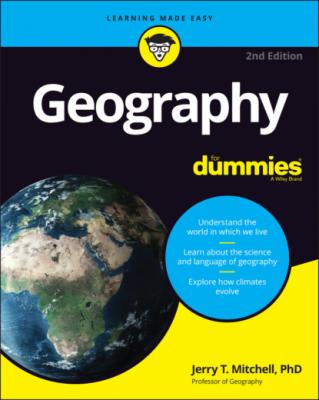ТОП просматриваемых книг сайта:
Geography For Dummies. Jerry T. Mitchell
Читать онлайн.Название Geography For Dummies
Год выпуска 0
isbn 9781119867142
Автор произведения Jerry T. Mitchell
Жанр География
Издательство John Wiley & Sons Limited
… To modern discipline
During the past two centuries, and especially during the past several decades, geography has blossomed and diversified. Old approaches that focused on location and description have been complemented by new approaches that emphasize analysis, explanation, and significance. On top of that, satellites, computers, and other technologies now allow geographers to record and analyze information about Earth to an extent and degree of sophistication that were unimaginable just a few years ago.
In the third century B.C., the Greek scholar Eratosthenes made a remarkably accurate measurement of Earth’s circumference. At Syene (near Aswan, Egypt), the sun illuminated the bottom of a well only one day every year. Eratosthenes inferred correctly this could only happen if the sun were directly overhead the well — that is, 90° above the horizon. By comparing that sun angle with another one measured in Alexandria, Egypt, on the same day the sun was directly overhead at Syene, Eratosthenes deduced that the distance between the two locations was one-fiftieth (1/50th) of Earth’s circumference. Thus, if he could measure the distance from Syene to Alexandria and multiply that number times 50, the answer would be the distance around the entire Earth.
There are diverse accounts of the method of measurement. Some say Eratosthenes had his assistants count camel strides (yes, camel strides) that they measured in stade, the Greek unit of measurement. In any event, he came up with a distance of 500 miles between Syene and Alexandria. That meant Earth was about [500 x 50 =] 25,000 miles around (“about” because the relationship between stade and miles is not exactly known). The actual circumference is 24,901 miles at the equator, so Eratosthenes was very close.
Interesting fact: The circumference is 41 miles less pole to pole; more on that in Chapter 4!
About a century-and-a-half later, another Greek named Posidonius calculated Earth’s circumference and due to differences in the lengths of Roman versus Greek stadia, others reported his measurement as 18,000 miles. Posidonius’ measurement became the generally accepted distance mainly thanks to Strabo, the great Roman chronicler, who simply did not believe that Earth could be as big as Eratosthenes said it was. About 18 A.D. Strabo wrote his Geography, which became the most influential treatise on the subject for more than a millennium. Geography credited the calculations of Posidonius and rejected those of Eratosthenes. And that leads to an interesting bit of speculation. Columbus was familiar with Geography, so he was aware of the official calculation of Earth’s circumference — 18,000 miles. Had he known the true circumference was 25,000 miles, like Eratosthenes said, Columbus would have known that China was thousands of miles farther to the west than Strabo suggested. And if he had known the true distance to China, would Columbus ever have set sail?
As a result, modern geographers are into all kinds of stuff. Some specialize in patterns of climate and climate change. Others investigate the distribution of diseases, or the location of health care facilities. Still others specialize in urban and regional planning, or resource conservation, or issues of social justice and equality, or patterns of crime, or optimal locations for businesses — the list goes on and on. Certainly, the ancient ge and graphe still apply, but geography is much more than it used to be.
Exposing Misconceptions: More Than Maps and Trivia
Geography is a widely misunderstood subject. Many people believe it’s only about making maps, studying maps, and memorizing locations. One reason is that polls and pundits occasionally decry the “geographic ignorance” of Americans, which usually means the average person doesn’t know where important things are located. Presumably, therefore, if you memorize the world map, then you “know geography.” Another reason is that on many TV quiz shows, contestants are occasionally asked “geography questions.” Almost always, the answer is a fact that can be understood by studying a map and/or memorizing the locations of things or events.
Knowledge of the location of things is important and useful. Everything happens somewhere; and if you know the where, then the event has meaning that it otherwise would not. So map memorization is cool, but you need to keep it in perspective. Memorizing locations is to geography what memorizing dates is to history, or what memorizing the multiplication table is to mathematics. Namely, it’s a foundation — a base — upon which you can build and develop deeper understandings.
The Geographic Advantage
Geographers still make maps and study them, and certainly, geography still consists of subject matter that cries out to be memorized. But map memorization and descriptive studies take a back seat to analysis, explanation, and significance. Geographers have a unique lens by which they try to understand Earth, and this approach comes with several advantages.
Geographer Susan Hanson described the Geographic Advantage as a focus on the
relationships between people and the environment
importance of spatial variability
processes operating at multiple and interlocking geographic scales
integration of spatial and temporal analysis
What this means is that geographers, more than other scholars, look at how people interact with the natural world, appreciate how interactions vary from place to place and from the local to the global, and link those processes and changes over time.
What is the capital city of Indonesia?
To highlight the difference between old, descriptive geography (what far too many studied as “geography” in school) and analytical geography, first consider this question: What is the capital city

